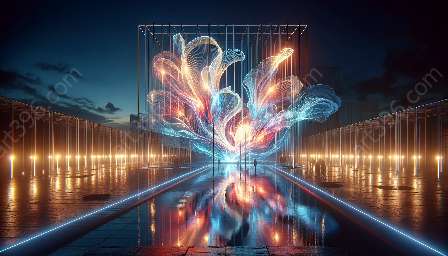Light art is a captivating form of artistic expression that seamlessly intersects with scientific concepts and phenomena. This unique form of art utilizes light as its primary medium, allowing artists to create stunning visual displays that evoke a sense of wonder and awe among viewers. In this comprehensive guide, we will explore how light art engages with scientific concepts, delve into the various types of light art, and gain a deeper understanding of this fascinating artistic genre.
Understanding Light Art
Before delving into the relationship between light art and scientific concepts, it is essential to grasp the essence of light art itself. Light art encompasses a wide range of artistic practices that utilize light as a central element in the creation of visual artworks. Artists harness various light sources, such as LEDs, lasers, and projections, to craft immersive and transformative experiences that captivate audiences.
Light art can take on diverse forms, including installations, sculptures, performances, and projections, and is often characterized by its ability to interact with and transform the surrounding environment. By manipulating light, artists can evoke emotions, convey narratives, and explore aspects of perception and sensory experiences.
Engagement with Scientific Concepts and Phenomena
One of the most intriguing aspects of light art is its inherent connection to scientific concepts and phenomena. Through the manipulation of light, artists intricately engage with principles from the fields of physics, optics, and perception. By employing scientific knowledge and experimentation, these artists create captivating visual experiences that subtly convey complex concepts in an accessible and enlightening manner.
Light art often delves into the properties of light, including reflection, refraction, diffraction, and the behavior of light waves. Artists utilize these principles to craft immersive installations that mesmerize viewers with their interplay of light and shadows, color spectrums, and spatial dimensions. Furthermore, the use of innovative lighting technologies and materials allows artists to push the boundaries of artistic expression and scientific exploration.
Furthermore, light art frequently explores the phenomenon of human vision and the psychology of perception. Through the manipulation of light and visual stimuli, artists can create illusions, distortions, and perceptual shifts that challenge viewers' understanding of reality and the environment around them. By doing so, light art not only engages with scientific ideas but also prompts contemplation about the nature of human experience and cognition.
Types of Light Art
Light art encompasses a diverse array of forms and styles, each offering unique insights into the intersection of art and science. Some of the prominent types of light art include:
- Sculptural Light Art: Artists create three-dimensional sculptures and installations using light as the primary medium. These sculptures often utilize light to define form, texture, and spatial relationships, resulting in visually striking and dynamic artworks.
- Interactive Light Art: This form of light art invites viewer participation and interaction, allowing individuals to influence and manipulate the visual elements through their movements, touch, or sound input. Interactive light artworks often blur the boundaries between the artist, the artwork, and the audience, fostering immersive and engaging experiences.
- Projection Mapping: Artists project light onto architectural surfaces or objects, transforming their appearances through intricate and precisely mapped visuals. Projection mapping creates illusions of movement, depth, and transformation, breathing life into static structures and environments.
- Light Installations: These large-scale, site-specific installations utilize light to transform entire spaces, creating immersive environments that envelop viewers in a captivating interplay of light and shadow. Light installations often evoke emotional responses and prompt contemplation about the relationship between light, space, and human experience.
- Performance Light Art: Artists incorporate light into live performances, combining visual elements with music, dance, or theatrical acts to create multisensory experiences. The dynamic and ephemeral nature of performance light art adds an element of spontaneity and temporality to the viewer's encounter with light.
By exploring these diverse forms of expression, artists continually push the boundaries of light art, engaging with scientific concepts and phenomena in innovative and thought-provoking ways.
Conclusion
Light art serves as a captivating medium through which artists engage with scientific concepts and phenomena, offering unique perspectives that blend artistry with scientific inquiry. By manipulating light and exploring its properties, light artists delve into the realms of physics, optics, and human perception, creating immersive experiences that resonate with audiences on intellectual and emotional levels. The various types of light art, from sculptural installations to interactive experiences, showcase the versatility and creativity present in this dynamic artistic genre. As the intersection of light art and scientific concepts continues to evolve, it promises to inspire and enthrall with its boundless potential and unending exploration of the mysteries of light.

